The ASUS TUF X99 Sabertooth Review
by Ian Cutress on July 22, 2015 10:00 AM EST- Posted in
- Motherboards
- Asus
- TUF
- X99
Gaming Performance 2015
Alien: Isolation
If first person survival mixed with horror is your sort of thing, then Alien: Isolation, based off of the Alien franchise, should be an interesting title. Developed by The Creative Assembly and released in October 2014, Alien: Isolation has won numerous awards from Game Of The Year to several top 10s/25s and Best Horror titles, ratcheting up over a million sales by February 2015. Alien: Isolation uses a custom built engine which includes dynamic sound effects and should be fully multi-core enabled.
For low end graphics, we test at 720p with Ultra settings, whereas for mid and high range graphics we bump this up to 1080p, taking the average frame rate as our marker with a scripted version of the built-in benchmark.

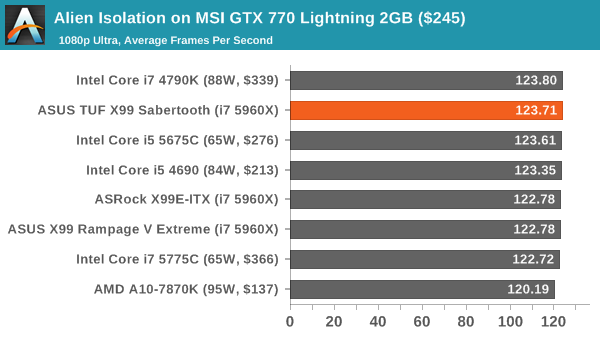
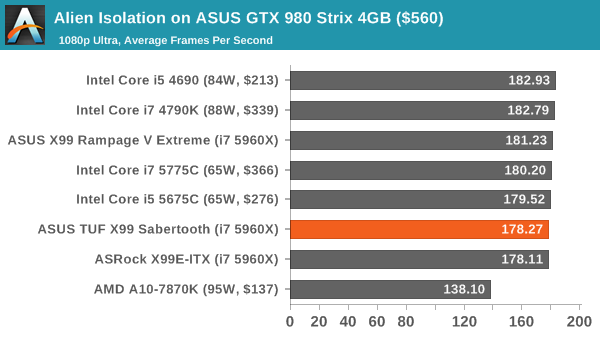
Total War: Attila
The Total War franchise moves on to Attila, another The Creative Assembly development, and is a stand-alone strategy title set in 395AD where the main story line lets the gamer take control of the leader of the Huns in order to conquer parts of the world. Graphically the game can render hundreds/thousands of units on screen at once, all with their individual actions and can put some of the big cards to task.
For low end graphics, we test at 720p with performance settings, recording the average frame rate. With mid and high range graphics, we test at 1080p with the quality setting. In both circumstances, unlimited video memory is enabled and the in-game scripted benchmark is used.
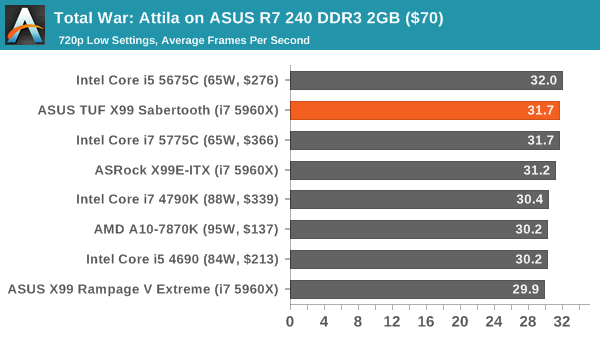
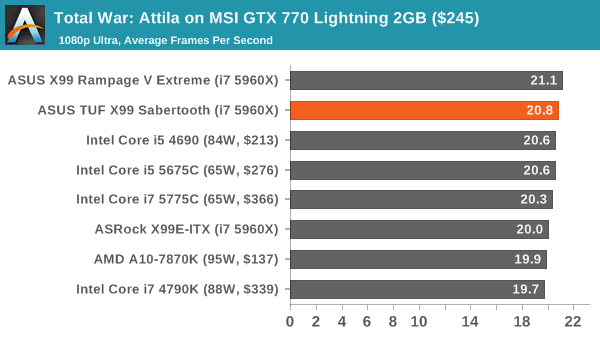
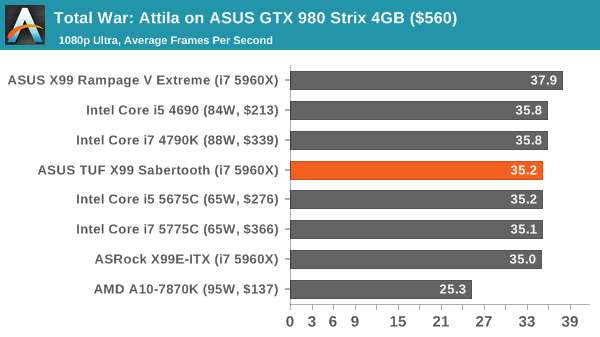
Grand Theft Auto V
The highly anticipated iteration of the Grand Theft Auto franchise finally hit the shelves on April 14th 2015, with both AMD and NVIDIA in tow to help optimize the title. GTA doesn’t provide graphical presets, but opens up the options to users and extends the boundaries by pushing even the hardest systems to the limit using Rockstar’s Advanced Game Engine. Whether the user is flying high in the mountains with long draw distances or dealing with assorted trash in the city, when cranked up to maximum it creates stunning visuals but hard work for both the CPU and the GPU.
For our test we have scripted a version of the in-game benchmark, relying only on the final part which combines a flight scene along with an in-city drive-by followed by a tanker explosion. For low end systems we test at 720p on the lowest settings, whereas mid and high end graphics play at 1080p with very high settings across the board. We record both the average frame rate and the percentage of frames under 60 FPS (16.6ms).

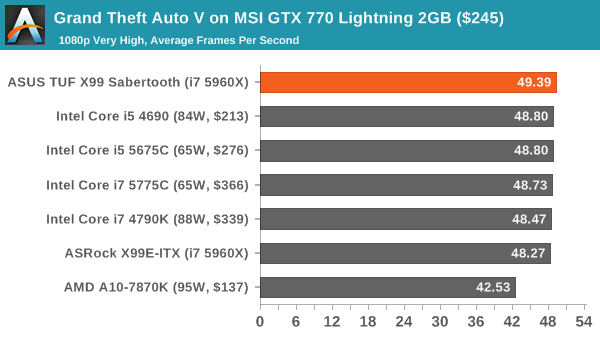
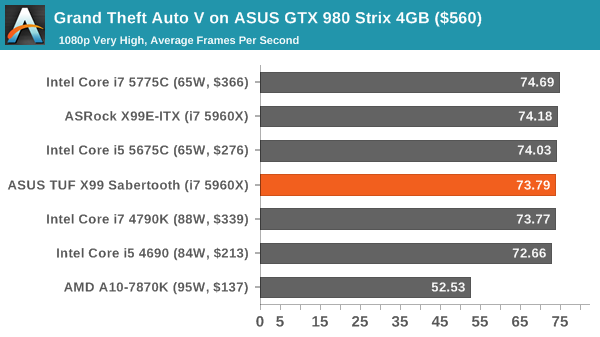
GRID: Autosport
No graphics tests are complete without some input from Codemasters and the EGO engine, which means for this round of testing we point towards GRID: Autosport, the next iteration in the GRID and racing genre. As with our previous racing testing, each update to the engine aims to add in effects, reflections, detail and realism, with Codemasters making ‘authenticity’ a main focal point for this version.
GRID’s benchmark mode is very flexible, and as a result we created a test race using a shortened version of the Red Bull Ring with twelve cars doing two laps. The car is focus starts last and is quite fast, but usually finishes second or third. For low end graphics we test at 1080p medium settings, whereas mid and high end graphics get the full 1080p maximum. Both the average and minimum frame rates are recorded.
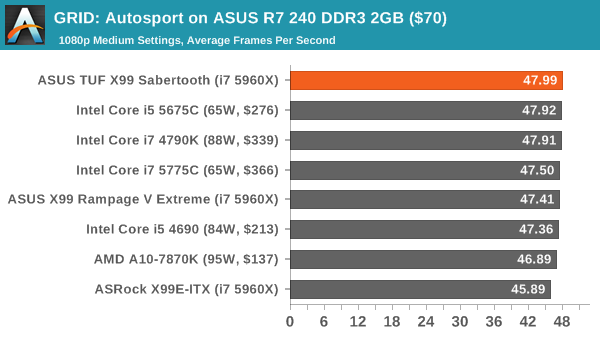
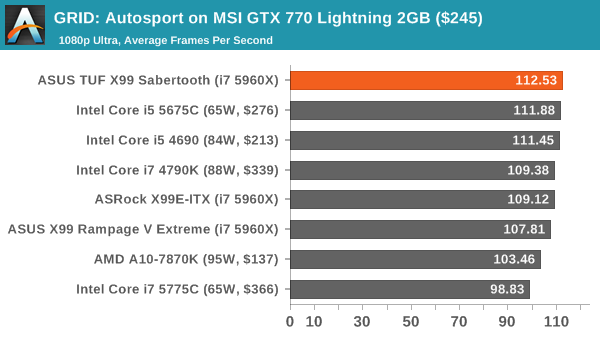
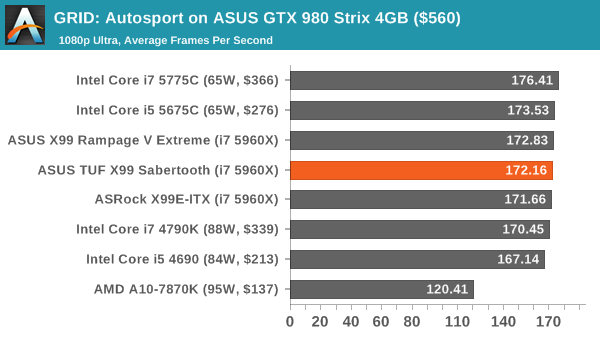
Middle-Earth: Shadows of Mordor
The final title in our testing is another battle of system performance with the open world action-adventure title, Shadows of Mordor. Produced by Monolith using the LithTech Jupiter EX engine and numerous detail add-ons, SoM goes for detail and complexity to a large extent, despite having to be cut down from the original plans. The main story itself was written by the same writer as Red Dead Redemption, and it received Zero Punctuation’s Game of The Year in 2014.
For testing purposes, SoM gives a dynamic screen resolution setting, allowing us to render at high resolutions that are then scaled down to the monitor. As a result, we get several tests using the in-game benchmark. For low end graphics we examine at 720p with low settings, whereas mid and high end graphics get 1080p Ultra. The top graphics test is also redone at 3840x2160, also with Ultra settings, and we also test two cards at 4K where possible.
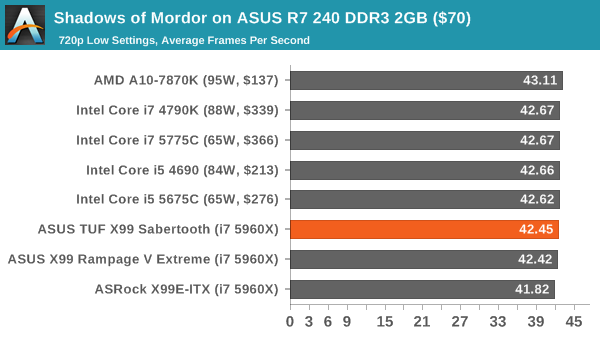
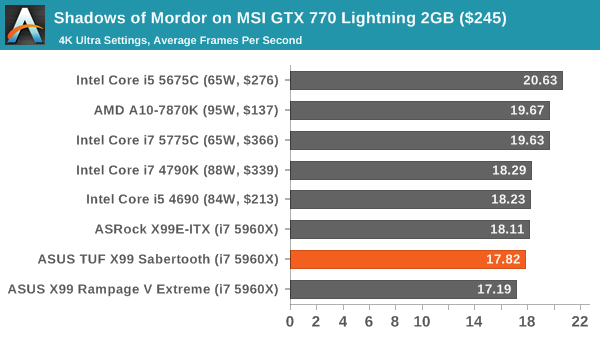

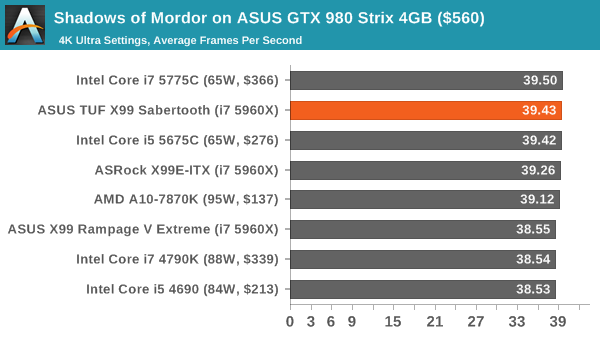
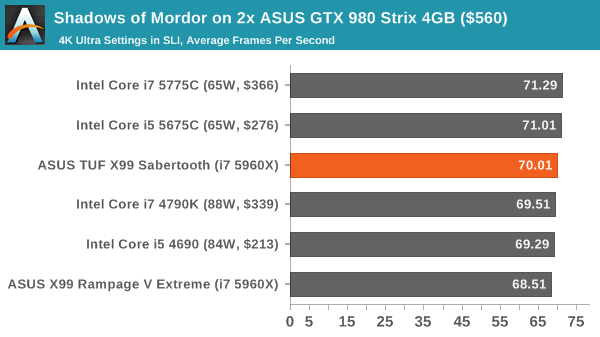















57 Comments
View All Comments
Ryangadz - Friday, July 24, 2015 - link
X79 and x99 are more geared for workstations with more ram and larger CPUs for multithreading. You're right they are not going to give you much extra performance for games...if any. Until DX12 fully kicks in a CPU with higher clock speed is best.dog55 - Saturday, July 25, 2015 - link
I dont if all M2.PCI ssd card suffer from heat throttling but the samsungs do (951).So I was wondering if you could comment on the covered slot for the drive- does it cool?
Zertzable - Saturday, July 25, 2015 - link
I recently had to RMA my X58 Sabertooth, needless to say I was quite happy about the five year warranty. That board and the i7-980X are definitely the best investment I've ever made in a PC, five years down the line and I still have basically no reason to upgrade. Fun fact: not that I care, but this "dinosaur" doesn't even have USB 3!mpdugas - Sunday, July 26, 2015 - link
Curiously, my Sabertooth Gen3/Rev 2 for 990FX only lasted two years before (first) the sound sub-system and then (second) the IDE controller chip-set failed, taking with it two IDE drives (a data drive and a backup data drive).Not very impressive for a "reliable" product, and my first MB failure in 20 years of building my own PCs.
iamkyle - Tuesday, July 28, 2015 - link
What do you expect? There is no actual validation for this being a "durable" product, just marketing fluff to move units.martfine - Sunday, January 3, 2016 - link
Hi - your specs say ddr4 Ram speed up to 2400MHz but Asus indicated 3200MHz .... Or am I missing something??Friksie - Friday, September 4, 2020 - link
Ook ik had het pech dat de CPU Intel 6850K kapot ging en helaas buiten de garantie (3 Jaar) viel dus die zijn vrij duur.Maar ik weet niet of dit al iemand heeft doorgegeven dat het ook door de waterkoeling kan stuk gaan! na veel zoeken kwam ik erachter dat de pomp van de Fraktal 24 S niet meer draaide en dat zie je nergens want alles functioneerde n.l. normaal.
Ook die viel net buiten de 3 jarige (alleen de TUF versie) garantie van Fractal design.
Eerst denk je dat het aan het moederbord ligt want alles draait alleen het start niet meer op en nu maar zoeken.
Je kunt met de TUF via een Mobile software de problemen opsporen maar wie heeft dat allemaal!
Door een andere CPU te testen kwam ik erachter dat het daaraan moest liggen de CPU was dus doordat de pomp niet draaide en dus niet meer koelde oververhit geraakt en boem stuk ging.
Dus wees gewaarschuwd kijk af en toe de waterkoeling goed na.